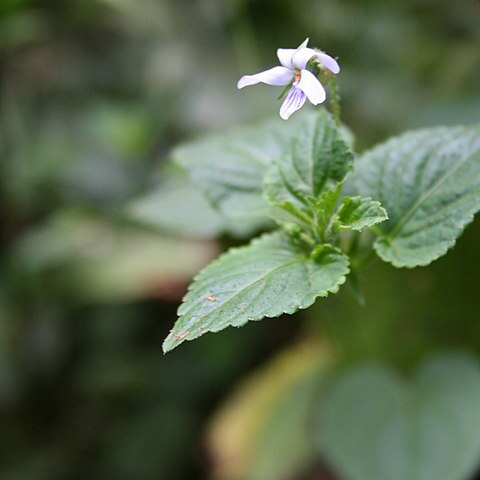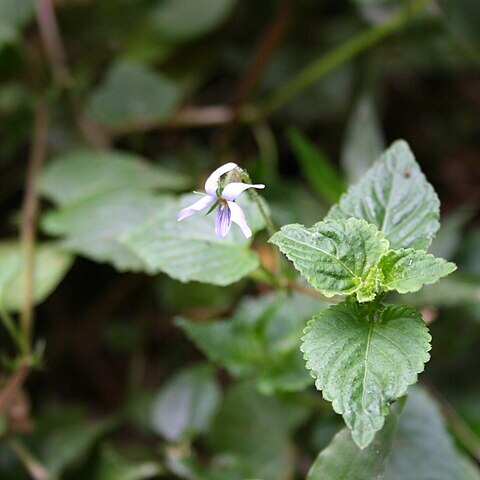Creeping or sometimes scrambling herbs from a perennial base, the long stems mostly unbranched, rooting at the nodes. Stems thin, narrowly winged. Leaves alternate, cordate, 1-2 cm long and broad, crenate, hispid, lower side usually with scattered resinous bodies; petiole slender, up to 2 cm long, stipules foliaceous, laciniate, setulose. Flowers axillary, solitary, declinate, persistent; pedicels thin, up to 5 cm long, bibracteate, inarticulate. Sepals more or less equal, narrowly ovate-acuminate, c. 5 mm long, with rudimentary basal bulges produced below the point of insertion. Petals with the 2 upper pairs whitish, obovate, 5-10 mm long; the anterior shorter, pale to dark blue or violet, veined, with a cylindrical large blunt spur adjoining the curved pedicel-apex. Stamens connivent, the apical connective appendage ovate, orange. Ovary globose, glabrous; style narrowly funnel-shaped, oblique. Capsule ovoid, c. 5 mm long, glabrous, pale; seed ovoid, 1-2 mm, several to many, with a distinct spongy aril.
Leaves petiolate; lamina 0.9–3.2 x 0.7–2.8 cm., broadly ovate to ovate-orbicular, rounded to shortly acuminate at the apex, cordate at the base, shallowly crenate-dentate, membranous, ± hirsute below, glabrous or ± hirsute between the main veins above; stipules and lamina often with reddish resinous streaks or dots; petiole 4–32 mm. long, usually shorter than the lamina, ± quadrangular, channelled above, glabrous or rarely ± hirsute, slender; stipules foliaceous, ovate to linear-lanceolate, laciniate, glabrous or ± hirsute.
Petals only slightly exceeding the sepals, oblong to obovate, rounded or obtuse, unequal, glabrous or hirsute along the midrib, mauvish-white to bluish-violet, paler towards the base, sometimes with reddish resinous dots; anterior petal 5–8 mm. long with a cylindric spur 2–3 mm. long, as long as the other petals or up to 1/3 shorter, with dark striations; lateral and upper petals paler, without dark striations.
Creeping or scrambling herb. Stems rooting at nodes. Leaves cordiform, soft, crenate. Seed ovoid, with distinct spongy aril. Upper 2 pairs of petals whitish; anterior petal pale to dark blue or violet.
Sepals linear to lanceolate, unequal, the lower pairs ± asymmetrical and curved upward, acute, entire, glabrous or ± hirsute, sometimes with reddish resinous streaks; appendages ± absent.
Stems up to 60 cm. long, trailing or creeping and rooting at the nodes, often growing erect through surrounding vegetation, angular or ± winged, glabrous or ± hirsute.
A herb that lies along the ground. The stems are slender. They form roots along the stem. The leaves are heart shaped. The flower petals form a sac.
Flowers single, axillary, pedicellate; pedicels 1–4 cm. long, slender, glabrous or ± hirsute, with two laciniate bracteoles in the upper part.
Anthers oblong-elliptic, shortly pubescent; connective-appendage orange, ± obtuse; tips of the spur-appendages hirsute.
Ovary ± globose, glabrous; style about equal to the ovary, cbconic, ± truncate or unequally 2-lobed at the apex.
Capsule 4–6 mm. long, pale yellow, 3-sided, acute, glabrous, coriaceous.
Seeds 1–2 mm. long, numerous per capsule, ellipsoid to globular.
Corolla very pale mauve to purple.
Creeping or weakly erect herb
Perennial herb.


